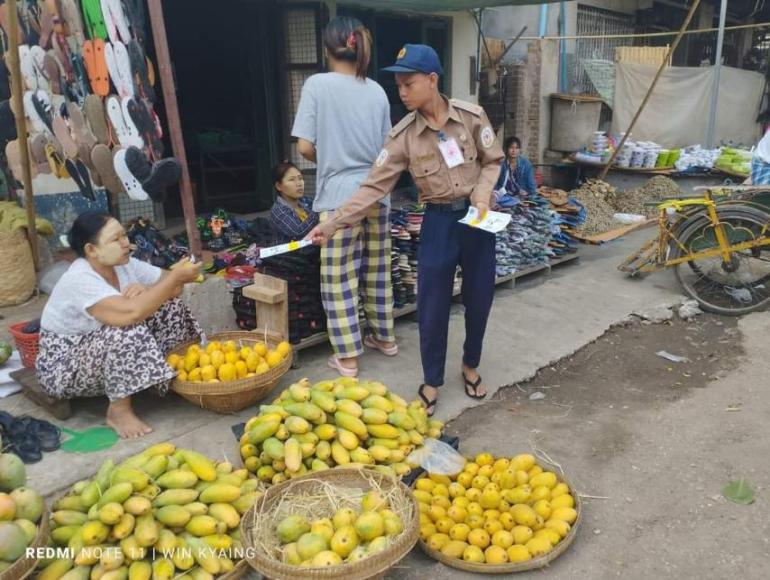Thousands evacuated as Cyclone Mocha nears Myanmar, Bangladesh
Fears for the safety of hundreds of thousands of vulnerable people in path of potentially devastating storm.

Thousands of people in Myanmar and Bangladesh are evacuating residents ahead of Cyclone Mocha, which is expected to bring winds as fast as 175km an hour (108 mph) when it makes landfall.
The storm is currently in the Bay of Bengal and moving northwards. It is expected to cross the coast between Sittwe in Myanmar’s northwestern Rakhine state and Cox’s Bazar in Bangladesh at around 12.30pm (06:00 GMT) on Sunday, according to the Myanmar Information Management Unit, which is tracking the storm system.
Keep reading
list of 4 itemsUnder pressure, ASEAN says ‘deeply concerned’ at Myanmar violence
Myanmar military used vacuum bomb on opponents: HRW
Myanmar aid convoy attack raises stakes for under-fire ASEAN
Authorities have warned of the danger of flooding, landslides and a storm surge of between 2 and 2.7 metres (6.6 feet to 8.9 feet).
“This is the first cyclone to threaten Myanmar this Monsoon season and there are grave concerns about the impact especially on already vulnerable and displaced communities,” the United Nations Office for the Coordination of Humanitarian Affairs (UNOCHA) said in an update on Friday. It noted that more than 230,000 people in Rakhine are living in camps for displaced people “located in low-lying coastal areas susceptible to storm surge”.
About six million people in areas in the path of the storm – Rakhine and the three northwestern states of Chin, Magway and Sagaing – were already in need of humanitarian assistance, UNOCHA added.
The ASEAN Coordinating Centre for Humanitarian Assistance on disaster management (AHA Centre) warned of the potential for a “catastrophic disaster” and said it was coordinating with Myanmar’s military for its aircraft to pick up stockpiles of essential supplies form warehouses in Thailand and Malaysia.
With information as of this morning, 13 May 2023, 00:30 AM Myanmar Time, forecast map of Cyclone Mocha has been updated. It is now available on MIMU’s dedicated page along with other resources. https://t.co/GyFPicePZP pic.twitter.com/CJqXmAWjvr
— MIMU (@the_MIMU) May 13, 2023
Myanmar was plunged into crisis in February 2021 when the military seized power from the elected government of Aung San Suu Kyi.
Fighting between the military and civilian armed groups known as the People’s Defence Forces (PDF) has been raging in many of the areas now threatened by the storm and, the areas at risk are not fully controlled by a single authority, which is likely to complicate the response.
Many residents have already been forced out of their homes due to aerial bombardment and arson attacks by the military, while internet and telecommunications blackouts in some townships could prevent people from receiving disaster alerts, the Chin Human RIghts Organisation warned.
The army used similar tactics in Rakhine in 2017 when it drove hundreds of thousands of mostly Muslim Rohingya across the border into Bangladesh where they continue to live in sprawling refugee camps.
Those settlements are also vulnerable to Cyclone Mocha and Bangladeshi authorities have said mosques as well as offices in the camps will be used as cyclone shelters. Preparations for the storm were also underway at Bhasan Char, a remote and low-lying island where Bangladesh has moved thousands of Rohingya.
Writing on Twitter, Tom Andrews, the UN’s special rapporteur on human rights in Myanmar said he was “terrified at the triple whammy threatening millions in the path of Cyclone Mocha: mass displacement driven by Myanmar military attacks; a humanitarian crisis exacerbated by world indifference; the extreme vulnerability of those stuck in flimsy shelters in flood prone areas.”
UNOCHA said it had deployed a team to Sittwe in advance of the storm, while the International Federation of the Red Cross (IFRC) said it was working with the Myanmar Red Cross to pre-position food and other essentials as well as prepare rescue and relief equipment.
“There will be important needs in terms of emergency housing, access to safe drinking water and hygiene, and attending to the displaced,” Nadia Khoury, the IFRC’s head of delegation in Myanmar, said in a statement on Saturday. “We can expect a significant humanitarian response.”
Military-appointed officials in Rakhine were also preparing for the storm, according to reports in the state-run Global New Light of Myanmar.

On Telegram, meanwhile, the Humanitarian and Development Coordination Office of the United League of Arakan (ULA) said it was working with other organisations to move those at risk to “safe areas”. The ULA, the political wing of the Arakan Army, claims administrative control of some two-thirds of Rakhine state.
Wai Wai Nu, a human rights advocate and founder of Women’s Peace Network, said she had spoken to Rohingya in Rakhine who had told her no-one was helping them, and that help was “non existent” in Maungdaw and Buthidaung.
“#CycloneMocha may embolden #Myanmar junta to use the disaster to expand its brutal control,” she wrote on Twitter.
In 2008, more than 130,000 people were killed when Cyclone Nargis tore across the low-lying Irrawaddy Delta. The scale of the devastation was so vast, the then-military government was forced to call in international assistance.
Thant Zaw said he lost several family members in Cyclone Nargis and had decided to take shelter at a monastery in Sittwe, the state capital.
“I told my family we should shelter at this monastery,” the 42-year-old told the AFP news agency.
“I have six children and I can’t lose my family again.”